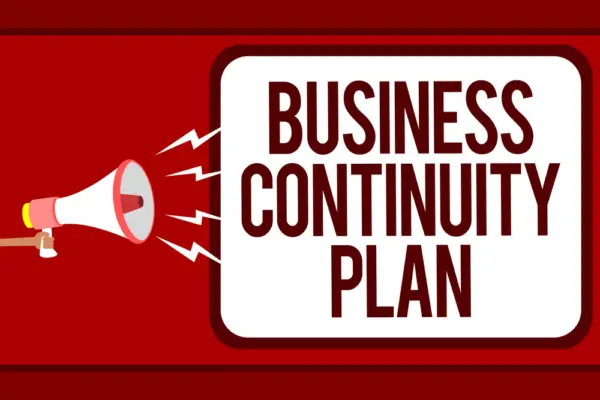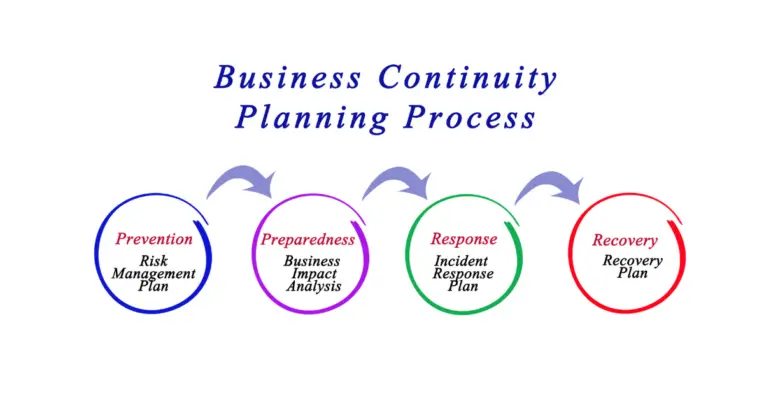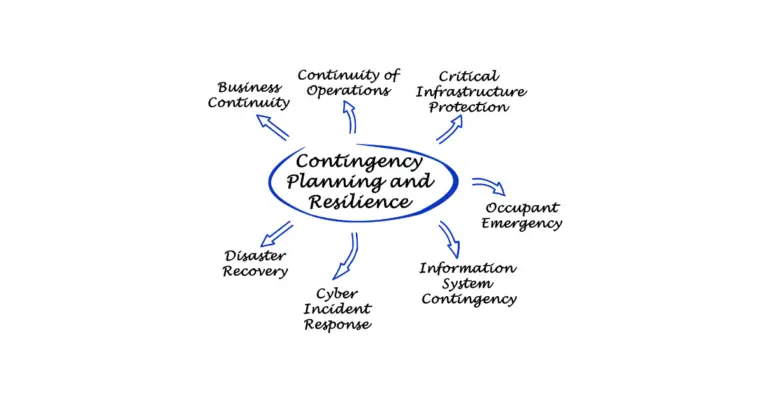Business Continuity Management, Don’t think that a disaster will happen to an organization? It’s not too late.
Take a look at these statistics: 10% of businesses fail in their first year, 50% fail within the next five years, and 90% are gone within 15 years. These rates are increasing exponentially with time.
The odds aren’t in your favor, so you should take proactive steps to ensure business continuity.
Every organisation should adhere to key elements of business continuity management. The first step is risk assessment. You need to understand where your vulnerabilities lie and what could potentially cause a disruption to your business.
Once you know this, you can implement strategies and protocols to mitigate those risks.
Another key element is contingency planning. You need to have a plan for what you will do if a disaster occurs.
This plan should include how you will communicate with employees, customers, and other stakeholders and what resources you will need to get your business back up and running.
A third key element is testing and exercises. You need to periodically test your plans and exercises to make sure they are effective and that employees are properly trained. This helps ensure that your business continuity plan will work if a disaster occurs.
If you want to ensure your business’s survival, ensure you have a robust business continuity management plan in place. These key elements are a good starting point.

Risk Assessment
Risk assessment is the process of identifying, analyzing, and responding to risks. It is an important part of business continuity management (BCM) because it helps organizations identify which risks are most likely to occur and which ones could have the biggest impact on operations.
Identify key risks during the risk assessment exercise.
BCM is a framework for ensuring that an organization can continue to function in the event of an emergency or disruption.
A well-designed BCM program will include plans and procedures for dealing with various types of risks, and risk assessment is a key part of those plans.
Organizations can develop strategies for mitigating or avoiding risks by identifying and assessing them. This helps to ensure that businesses can keep operating even in the face of adversity.
Any business continuity plan (BCP) should include a risk assessment in order to identify potential threats to the company and its operations.
There are a number of steps that should be taken in order to perform a comprehensive risk assessment. First, an analysis of the company’s vulnerabilities should be conducted.
This includes identifying critical functions, resources, and systems and examining external factors such as the supply chain, weather patterns, and political instability.
Next, each identified threat’s likelihood and potential impact should be estimated. Finally, mitigation strategies should be implemented to reduce the risk of disruptions. By taking these steps, companies can develop a robust BCP that will help them to weather any storm.
One of the key components of any successful Business Continuity plan is a comprehensive risk assessment.
This assessment must identify all potential risks to the business, no matter how unlikely they may seem. However, this can be a daunting task, and there are a number of challenges that must be overcome.
First, it can be difficult to identify all potential risks. Second, even if all risks are identified, assessing their likelihood and potential impact can be hard.
Finally, once the risks are known, creating contingency plans that address them effectively can be difficult.
Despite these challenges, risk assessment is essential for any Business Continuity plan to be successful. By taking the time to identify and assess all potential risks carefully, businesses can ensure that they are prepared.
One of the most important aspects of effective business continuity management is carrying out accurate risk assessments.
Identifying and preparing for potential risks and hazards is crucial for business readiness.
However, conducting an effective risk assessment is not always easy. Here are a few tips to help you get it right:
- Make sure you involve all the relevant stakeholders in the process. This will help you to get a clear understanding of the potential risks and how they could impact your business.
- Carry out a comprehensive review of your business operations. This will help you identify any potential weaknesses that could be exploited in a disaster.
- Use a consistent methodology for assessing risk. This will ensure that your assessment.
It is critical to have an up-to-date risk assessment for business continuity purposes. Best practices for performing such assessments include:
1) ensure that the assessment is comprehensive and covers all potential risks;
2) use a tool or template that is fit for purpose and easy to use;
3) involve key stakeholders in the process;
4) ensure that the assessment is regularly updated. Organizations can confidently use these best practices to ensure their risk assessments provide the information needed for business continuity planning.

Contingency Planning
Contingency planning is a vital part of any business continuity management (BCM) program. It involves creating a plan to deal with unexpected disruptions, such as power outages, natural disasters, and IT failures.
Having a contingency plan in place can minimize disruptions and ensure quick resumption of operations for businesses.
Establishing a contingency planning process is essential for any organization in order to prepare for a wide variety of risks.
This process entails obtaining important organizational information, identifying possible risks and the likelihood of them occurring, rating the seriousness of each risk and finally, creating preventive strategies to avoid or lessen the impact of those risks.
Evaluating and monitoring the effectiveness of these strategies will help ensure that an organization can stay on top of any changes in risk levels or unexpected scenarios that may arise.
It is important for business continuity management systems to review and adjust these plans periodically as every situation will be different, allowing it to respond quickly and effectively to any potential threats.
4 major components of contingency planning
The four major components of contingency planning are mitigation, preparation, response, and recovery.
Mitigation requires risk identification and measures such as employee training or changing operational models to reduce potential future damages.
Preparation includes designating roles and responsibilities for emergency incidents and preparing emergency assembly points.
Response covers recognizing signs of a crisis and enacting emergency procedures. Recovery considers how to resume critical operations after the incident occurs quickly.
contingency plan vs continuity plan
A contingency plan and a continuity plan are two approaches companies use to prepare for uncertainties that may arise.
Contingency plans outline specific steps organizations should take if something unexpected occurs, typically in the form of a series of ‘if-then’ scenarios. It also includes emergency response procedures.
Meanwhile, a continuity plan takes a broader approach and sets out guidelines for the business’s continued operations despite disruption.
It focuses more on long-term planning, with elements such as staying agile, increasing communication among staff, and training personnel to use new technology.
A business continuity plan is derived from the business continuity management process.
While the details of each contingency plan will vary depending on the specific needs of the organization, some common elements should be included.
These include identifying critical business functions, establishing alternate work locations, and creating communication plans.
By taking these steps, businesses can reduce the impact of disruptions and ensure that they can continue operating even in the face of adversity.
Many different types of contingencies can happen in a business. A contingency is an uncertain event or condition that may or may not occur.
For example, a business may have a contingency plan if a key supplier leaves. Contingencies can be internal or external, and they can be positive or negative.
Some common contingencies include natural disasters, financial crises, technological failures, and political instability.
Businesses need to be prepared for all contingencies in order to minimize the impact on operations.
A good contingency plan can help a business continue operating even in the face of adversity. BCM key risks need to have separate BCPs.
The first step to developing a contingency plan is to identify the organization’s critical functions.
These are the functions that must continue to be performed in order for the organization to remain operational.
Once the critical functions have been identified, the next step is to develop plans for how they will be maintained during an interruption.
This may include developing alternative workflows, establishing backup systems, or coordinating with other organizations.
Testing your contingency plan is an essential part of BCM. Testing allows you to identify any weaknesses in your plan and make improvements before relying on the plan.
It also helps to build confidence in the plan and ensure that everyone knows what to do in the event of an emergency.
There are many different ways to test a contingency plan. One common method is to simulate a power outage or other disruption and then see how well the plan works in practice.
The contingency plan should be regularly reviewed and updated as needed. If something does go wrong, it is important to have a clear and well-executed plan in place to minimize the disruption to the business.
Regularly updating and reviewing contingency plans can ensure businesses are prepared for any situation.
Many businesses put together contingency plans in case something goes wrong, but few take the time to avoid the common pitfalls that can make these plans ineffective.
One of the most common mistakes is failing to identify all the potential risks. This can result in a plan that doesn’t address the full scope of possible problems.
Another common issue is not involving all the relevant stakeholders in the planning process.
This can lead to a lack of buy-in from key individuals, making it difficult to implement the plan when needed.
Additionally, some plans are too rigid, making it difficult to adapt when unexpected events occur.
The best way to avoid these pitfalls is to take a comprehensive and flexible approach to contingency planning.

Testing and Exercises
Testing is important for BCM programs/plans/policies to assess their functionality and to identify potential improvements.
By conducting tests, organizations can determine whether their BCM procedures and key components of business continuity management are effective and meet the intended purpose.
Testing also allows organizations to identify gaps in their knowledge and understanding, which can be addressed through training and exercises.
On the other hand, exercises allow organizations to practice their BCM procedures under controlled conditions.
Exercises help organizations validate plans, and procedures, and identify improvement areas.
Ultimately, testing and exercising are essential for ensuring that BCM programs/plans/policies are effective and ready to be implemented during an actual disruptive event.
Many types of tests and exercises can be used to evaluate business continuity plans. One common type is the tabletop exercise, used to test plan feasibility and identify potential weaknesses.
Another popular option is the full-scale exercise, which simulates a real-life disaster scenario in order to measure response time and effectiveness.
Additionally, some organizations choose to conduct annual or semi-annual audits of their continuity plans. These audits can help identify improvement areas and ensure that plans are up to date.
Ultimately, the type of test or exercise conducted will depend on the organisation’s specific needs.
However, all tests and exercises should be designed with the goal of ensuring that businesses are prepared to respond effectively to any type of disruption.
There are several things to remember when testing and exercising for BCM. First, it is important to establish realistic scenarios.
This will help ensure the test is as effective as possible in identifying weak points. Second, all members of the organization should be involved in the exercise so that everyone is aware of their roles and responsibilities in the event of a disruption.
Finally, a debriefing should be conducted after the exercise to identify any areas that need improvement.

Benefits of testing:
- Enables an organization to prioritize and focus remediation efforts.
- Provides a historical record of vulnerabilities that can be used for future compliance audits.
- Identifies new attack vectors and trends in cyberattacks.
- It helps identify malicious activity and compromised systems.
Benefits of exercising :
- Ensures business continuity by enabling organizations to test their recovery plans under real-world conditions.
- Reduces the chances of a successful cyberattack by increasing an organisation’s defensive posture.
- Facilitates communication and coordination among stakeholders during an incident response.
Challenges with testing and exercising
- Ensuring that tests and exercises are relevant to the current state of the BCM program. This means regularly reviewing and updating test plans and scenarios and keeping abreast of changes in the overall business environment.
- Maintaining the level of interest and engagement from senior management and other stakeholders. Getting everyone on board with testing and exercising can be difficult, especially if it hasn’t been done before or if there isn’t a clear understanding of its value.
- Devoting adequate resources to tests and exercises. This includes human resources (e.g., identifying and responding, and Coordinating testing and exercises across different functions and teams.
- Ensuring that tests and exercises are realistic and challenging enough to test the BCM plans and procedures adequately.
- Conducting tests and exercises on a regular basis, keeping them up-to-date with changes in the business environment.
- Documenting the results of tests and exercises so that lessons learned can be fed back into the BCM planning process.
- Managing stakeholders’ expectations around testing and exercise activities.
Conclusion
Key elements of business continuity management are risk assessment, contingency planning, and testing and exercises.
Have you put a business continuity management plan in place for your organization? If not, now is the time to start.
While no one can predict when or how a disaster will occur, by planning ahead and being prepared, an organization can mitigate the damage and get back up and running as quickly as possible.
Have you implemented all four key elements of business continuity management in your organization?

Chris Ekai is a Risk Management expert with over 10 years of experience in the field. He has a Master’s(MSc) degree in Risk Management from University of Portsmouth and is a CPA and Finance professional. He currently works as a Content Manager at Risk Publishing, writing about Enterprise Risk Management, Business Continuity Management and Project Management.

